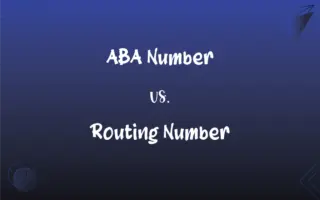Grains vs. Cereals: What's the Difference?
Edited by Harlon Moss || By Janet White || Published on December 5, 2023
Grains refers to small, hard, dry seeds harvested for human or animal consumption. Cereals: Grasses refers to cultivated for the edible components of their grain.

Key Differences
Grains refer to the small, hard seeds of various plants, especially those harvested for food. In contrast, cereals specifically denote grains produced by cereal crops, which are members of the grass family.
All cereals are grains, but not all grains are cereals; grains include seeds from a variety of plant families. While, cereals are grains that come specifically from cereal crops like wheat, rice, and corn.
Grains can be used in a wide range of foods and industrial products. Whereas, cereals, being a subset of grains, are primarily used in foods like bread, porridge, and breakfast cereals.
Grains encompass a broader category, including seeds like quinoa and buckwheat. Cereals are restricted to certain grass crops, which are staple foods globally.
The term 'grains' often refers to both the seeds and the plants they come from. 'Cereals' generally refers to the edible grain seeds harvested from cereal crops.
ADVERTISEMENT
Comparison Chart
Definition
Small, hard seeds from various plants.
Grains from cereal crops, a type of grass.
Variety
Includes seeds from various plant families.
Restricted to certain grass family crops.
Usage
Wide range, including food and industry.
Primarily in food products like bread.
Examples
Quinoa, buckwheat, rice, wheat.
Wheat, rice, corn, barley, oats.
Botanical Classification
From different plant families.
Specifically from the grass family.
ADVERTISEMENT
Grains and Cereals Definitions
Grains
Small, hard seeds used for food.
The farmer harvested grains from his fields.
Cereals
A type of grass cultivated for its seed.
Cereals form the basis of many diets around the world.
Grains
Any small, hard, dry seed, with or without an attached hull.
Ancient grains have become popular for their nutritional value.
Cereals
Plants of the Gramineae family yielding edible grains.
The field was planted with cereals for the coming season.
Grains
The seeds of grasses cultivated for food.
Grains like rice and wheat are essential in our diet.
Cereals
Grasses cultivated for the edible components of their fruit.
Cereals like corn and wheat are staple foods globally.
Grains
A small, dry, one-seeded fruit of a cereal plant.
The grains were ground into flour for baking.
Cereals
Edible grains such as wheat, rice, and corn.
Breakfast cereals often contain processed cereal grains.
Grains
The harvested seeds of various cereal and leguminous plants.
A variety of grains are used to make multi-grain bread.
Cereals
The grains of cereal plants, used for human food or fodder.
The cereals were harvested to be processed into flour.
Grains
A small, dry, one-seeded fruit of a cereal grass, having the fruit and the seed walls united
A single grain of wheat.
Gleaned the grains from the ground one at a time. Also called caryopsis.
Cereals
A grass such as wheat, oats, or corn, the starchy grains of which are used as food.
Grains
The fruits of cereal grasses especially after having been harvested, considered as a group
The grain was stored in a silo.
Cereals
The grain of such a grass.
Cereals
Any of several other plants or their edible seeds or fruit, such as buckwheat or certain species of amaranth.
Cereals
A food prepared from any of these plants, especially a breakfast food made from commercially processed grain.
Cereals
Consisting of or relating to grain or to a plant producing grain.
Cereals
Plural of cereal
FAQs
What's a common use for grains?
For food products like bread, cereals, and pasta.
What are grains?
Small, hard seeds from various plants, used for consumption.
What are cereals?
Grains from cereal crops, specifically grasses like wheat and rice.
Are all cereals grains?
Yes, all cereals are a type of grain.
Can grains be used for non-food purposes?
Yes, grains have various industrial uses.
What's a common use for cereals?
Mainly in food products, especially breakfast cereals and bread.
Are all grains cereals?
No, not all grains are cereals; only those from cereal crops.
Are cereals used for animal feed?
Yes, some cereals are also used as animal feed.
Are cereals good for health?
Yes, especially whole cereals, which are rich in nutrients.
Can grains be gluten-free?
Some, like quinoa and rice, are naturally gluten-free.
Are grains part of a vegan diet?
Yes, grains are a staple in many vegan diets.
How are cereals processed?
They are harvested, threshed, and often milled or processed.
Can cereals be part of a weight-loss diet?
Whole cereals can be, due to their high fiber content.
What are examples of grains?
Wheat, rice, quinoa, and buckwheat.
What are examples of cereals?
Wheat, rice, corn, oats, and barley.
Is corn considered a grain?
Yes, corn is a grain and specifically a cereal.
Do cereals contain gluten?
Some do, like wheat, while others like corn do not.
Is rice a grain or a cereal?
Rice is both a grain and a cereal.
How are grains harvested?
Through a process of reaping, threshing, and winnowing.
Do grains have health benefits?
Yes, many grains are nutritious and part of a balanced diet.
About Author
Written by
Janet WhiteJanet White has been an esteemed writer and blogger for Difference Wiki. Holding a Master's degree in Science and Medical Journalism from the prestigious Boston University, she has consistently demonstrated her expertise and passion for her field. When she's not immersed in her work, Janet relishes her time exercising, delving into a good book, and cherishing moments with friends and family.
Edited by
Harlon MossHarlon is a seasoned quality moderator and accomplished content writer for Difference Wiki. An alumnus of the prestigious University of California, he earned his degree in Computer Science. Leveraging his academic background, Harlon brings a meticulous and informed perspective to his work, ensuring content accuracy and excellence.































































